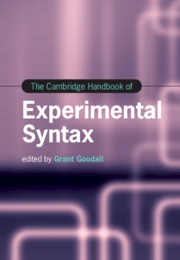Book contents
- The Cambridge Handbook of Experimental Syntax
- The Cambridge Handbook of Experimental Syntax
- Copyright page
- Contents
- Figures
- Tables
- Contributors
- Introduction
- Part I General Issues in Acceptability Experiments
- Part II Experimental Studies of Specific Phenomena
- Part III Experimental Studies of Specific Populations and Language Families
- 14 Acceptability Studies in L2 Populations
- 15 Judgments of Acceptability, Truth, and Felicity in Child Language
- 16 Acceptability and Truth-Value Judgment Studies in East Asian Languages
- 17 Acceptability Experiments in Romance Languages
- 18 Acceptability Studies in (Non-English) Germanic Languages
- 19 Acceptability Studies in Semitic Languages
- 20 Experimental Syntax and Slavic Languages
- 21 Acceptability Judgments in Sign Linguistics
- Part IV Experimental Syntax beyond Acceptability
- Index
- References
17 - Acceptability Experiments in Romance Languages
from Part III - Experimental Studies of Specific Populations and Language Families
Published online by Cambridge University Press: 16 December 2021
- The Cambridge Handbook of Experimental Syntax
- The Cambridge Handbook of Experimental Syntax
- Copyright page
- Contents
- Figures
- Tables
- Contributors
- Introduction
- Part I General Issues in Acceptability Experiments
- Part II Experimental Studies of Specific Phenomena
- Part III Experimental Studies of Specific Populations and Language Families
- 14 Acceptability Studies in L2 Populations
- 15 Judgments of Acceptability, Truth, and Felicity in Child Language
- 16 Acceptability and Truth-Value Judgment Studies in East Asian Languages
- 17 Acceptability Experiments in Romance Languages
- 18 Acceptability Studies in (Non-English) Germanic Languages
- 19 Acceptability Studies in Semitic Languages
- 20 Experimental Syntax and Slavic Languages
- 21 Acceptability Judgments in Sign Linguistics
- Part IV Experimental Syntax beyond Acceptability
- Index
- References
Summary
We present a selective review of studies on Romance languages wherein acceptability experiments played an important role in advancing our knowledge of the grammars of particular linguistic varieties and, by extension, furthering our knowledge of human language and linguistic theory. First, we examine recent studies on word order in wh-questions across varieties of Spanish. Next, we examine the value of acceptability experiments in the study of infrequent structures (e.g. clitic left-dislocation, focus fronting). We highlight the importance of data triangulation by examining studies of information focus in Spanish, emphasizing the impact that methodological choices can have on results. We also examine control and raising structures in Brazilian Portuguese, where conflicting results have required innovative methodological approaches. Since acceptability intuitions may be uniquely nuanced for minority languages, we also briefly discuss how data that is typically used in other theoretical paradigms can contribute to data triangulation with lesser-spoken Romance varieties.
Keywords
- Type
- Chapter
- Information
- The Cambridge Handbook of Experimental Syntax , pp. 448 - 476Publisher: Cambridge University PressPrint publication year: 2021
References
- 1
- Cited by



